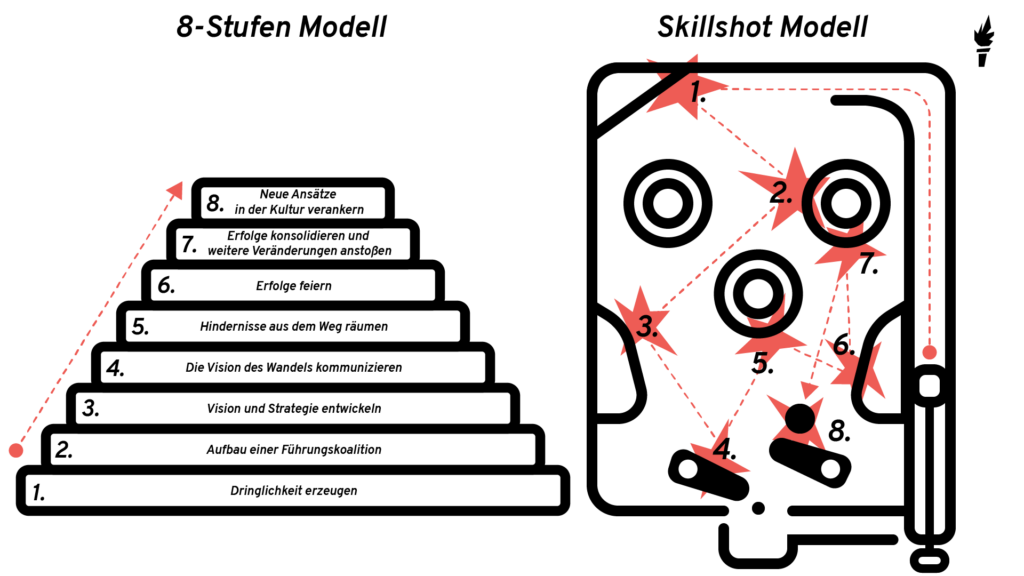
8 SKILLSHOTS: PINBALL-STYLE CHANGE MANAGEMENT
Change management, traditionally understood as a methodical approach, today resembles a dynamic pinball game. The analogy is apt: as in pinball, it is important to keep the balls – in our case the change processes – in play in an agile manner, to react quickly to unforeseeable events and to adapt skillfully. All of this requires the utmost attention and the ability to make, revise and realign decisions in real time.
Since the publication of John Kotter’s “Leading Change” in 1991 with its eight stages of change, this model has become one of the most popular frameworks in the field of change management. This enduring popularity over the decades is due to three aspects:
First, the model provides a clear, step-by-step guide that gives leaders structure and direction in the often overwhelming process of change.
Second, Kotter places great emphasis on the human side of change, emphasizing the importance of reaching people’s hearts and minds.

Thirdly, Kotter’s insights are based on real experiences rather than theoretical assumptions.
Today, however, the sequential nature of Kotter’s model seems too rigid. Modern change management is more like a pinball game in which managers have to keep several balls in play at the same time without losing control completely.
Skillshot 1: Create urgency
In order to initiate change, it is necessary for managers to act immediately and clearly communicate the urgency of the change. At Netflix, this was particularly clear when the company made the switch from the DVD mail order business to streaming. The defining moment came when management realized that the future of entertainment consumption was online. Netflix reacted quickly, communicated this strategic change of direction clearly and made every effort to align the organization with this new course. By clearly communicating the urgency to move away from the physical medium and into streaming, Netflix was able to mobilize the team and establish itself as the market leader in streaming. This transformation demonstrated Netflix’s ability to not only anticipate change, but also to act quickly, which is critical to continued success in an ever-changing market.
Skillshot 2: Building a leadership coalition
Gone are the days when a handful of top managers could single-handedly bring about profound change. Today, it takes a broad coalition that has the full range of digital skills and is able to communicate and inspire the workforce via social networks.
A pioneer in this regard is Adobe, the company behind creative software solutions such as Photoshop and Premiere Pro. Adobe has created a culture of collaboration and empowerment that encourages every employee to develop leadership skills and take responsibility. By establishing cross-functional teams that work together across departmental boundaries, Adobe leverages the collective knowledge and skills of its employees to respond quickly to changes in the technology market and drive innovation.
Skillshot 3: Develop vision and strategy
The ability to develop and adapt a vision is critical to a company’s long-term survival and success. At Microsoft, CEO Satya Nadella has led a groundbreaking transformation, transforming the company from one primarily focused on its Windows operating system to an innovation leader in cloud computing and artificial intelligence. This transformation reflects a comprehensive strategic realignment that emphasizes customer centricity and agility. Microsoft’s flexible strategy has allowed the company to seamlessly adapt to rapidly changing technologies and market demands and prepare for the integration of future innovations such as quantum computing.
Skillshot 4: Communicating the vision of change
Communicating a company’s vision must not only be compelling and clear, but also consistent across a variety of platforms and media today. The vision must be communicated in such a way that it is understood by all audiences – from stakeholders and employees to the general public. Tesla, with Elon Musk at the helm, has exemplified how effective a clear and consistent message can be. Musk uses every opportunity, from product unveilings to tweets, to reinforce Tesla’s message of accelerating the transition to sustainable energy. He knows how to communicate complex technologies in a way that not only informs but also inspires, which is critical to gaining support for breakthrough ideas.
Skillshot 5: Removing obstacles out of the way
In the wake of the digital revolution, removing internal obstacles is crucial to paving the way for Artificial Intelligence (AI). This includes overcoming technical challenges and training employees as well as addressing ethical issues. NVIDIA, a pioneer in AI, is overcoming these challenges by not only developing advanced AI platforms, but also investing in internal education programs. These programs are designed to train employees and prepare them for the changes in the world of work so that they can not only support the change, but actively shape it.
Skillshot 6: Celebrate successes
It is essential that teams can quickly recognize and appreciate their successes. This skillshot thrives on the momentum of the moment and the momentum that comes from recognizable progress. Zappos, a leading online footwear and apparel retailer known for its excellent customer service and innovative company culture, exemplifies this practice. A flat hierarchy shortens decision-making paths, which enables quick action and an equally quick sense of achievement. Achievements are communicated directly to the team and celebrated together, which keeps motivation high and promotes an atmosphere of shared aspiration and growth.
Skillshot 7: Consolidate successes and initiate further changes
After initial successes, it is important not only to celebrate them, but also to see them as a solid basis for future projects and innovations. Tesla is a masterful example of this. The company has managed not to rest on its laurels, but to use every success, be it in the production of electric vehicles, the development of battery technologies or the expansion of its Supercharger network, as a catalyst for the next innovation. By using success as a basis for further growth and as an incentive to overcome new challenges, Tesla continues to set new standards in the automotive industry. This strategy helps Tesla drive its vision to accelerate the transition to sustainable energy and continue to redefine the industry.
Skillshot 8: Embed new approaches in the culture
For sustainable change, it is crucial to deeply embed new processes and approaches into the corporate culture. An excellent example of this is Siemens, a global German company with a long tradition of innovation and technology. Siemens has recognized the importance of establishing a culture of continuous learning, flexibility and openness to change in order to stay ahead of the international competition. By fostering interdisciplinary teams, introducing agile working methods and a strong commitment to sustainability and digitalization, Siemens has shown how to create a corporate culture that not only drives innovation, but also encourages employees to continuously seek improvements and new solutions.
As with pinball, change management in the era of real-time communication requires skill, timing and a willingness to react quickly. Although Kotter’s model is still valuable decades later, the linear step-by-step model seems outdated. Many of Kotter’s steps need to be managed in parallel, which requires more agility and empathy. The companies in our examples show that it is perfectly possible to keep all the balls in play at the same time and not only survive, but also constantly change and grow as a company.


